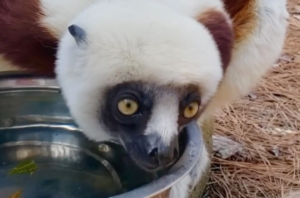Keeping Cool at the DLC
On a typical mid-summer day in Durham, North Carolina, visitors flock to the Duke Lemur Center to take a tour—hopefully one of the earlier ones—and meet some of Madagascar’s most beloved species. It only takes about five minutes after leaving the air-conditioned visitor’s center to start sweating. The sun beats down, the humidity is stifling, and while the lemurs are usually up and about, you may catch them sprawled out napping if you arrive during the heat of the day. After the tour, guests can retreat back into the cool gift shop, drink water, and maybe decide to go for an ice cream run on their way home. But for the lemur residents of the DLC, who spend most of the summer out in the forest or in their outdoor habitats, there are plenty of other ways to beat the heat!

Water bowls are refreshed throughout the day to ensure the lemurs stay cool and hydrated. Here a Coquerel’s sifaka enjoys a drink in one of the DLC’s Natural Habitat Enclosures.
Lemurs are endemic to Madagascar, which is located just south of the equator and boasts balmy tropical temperatures year-round. While the wet and dry seasons see extreme changes in precipitation (rainfall), temperatures only vary by 20-30 degrees on average from the hottest to the coldest parts of the year. Average temperatures range from the low 60s to the low 80s, but some areas in Madagascar can see temperatures as high as 90 degrees Fahrenheit, while some areas at high elevations can have frosty nights. Lemurs inhabit a wide variety of habitat types on the island and are adapted to a range of seasonal conditions, including precipitation and humidity. The shift to North Carolina climate is not as big a jump as one might think: Durham’s average temperatures range from the low 40s to the high 80s on average, with some occasional lows in the 20s and highs in the 100s. Lemurs living at the DLC experience temperatures a bit higher and a bit lower than what they would experience in their homeland, so there are systems in place to make sure no animals get heat or cold stress.

A ring-tailed lemur engages in hand-licking behavior to cool off on a hot NC summer day.
Lemurs can do quite a bit of thermoregulation on their own—behavioral tactics to assist in warming or cooling of the body. Animals have incredible adaptations to assist in thermoregulation, and lemurs are no exception. In chillier conditions, lemurs are known to huddle into a “lemur ball,” wrapping bodies and tails tightly around one another for maximum warmth. Warmer weather sees the opposite—families spread out in the trees, moms nudge babies off their backs, and everyone stretches out to maximize cooling. A spread-out afternoon nap is a common way for lemurs to conserve energy and maximize body evaporation, but sometimes they need a little extra help. Tree-hugging is a common behavior to help cool a warm belly, and if needed, lemurs might lick their hands and feet to encourage more evaporation. Since lemurs don’t sweat like humans or pant like dogs, this hand-licking behavior is a crucial way for them to allow heat to evaporate from their skin. Just like humans, additional hydration, shady spots, and taking it easy are all important summer staples.

A Coquerel’s sifaka hugs a tree branch in the heat of the summer in a Natural Habitat Enclosure.
When keepers at the DLC see the lemurs exhibiting these cooling behaviors, they usually check in and make sure no one is experiencing heat stress. Lemurs in the free-range forest enclosures have 24-hour access to their winter housing, which is much cooler than the forest and has more regulated airflow than the outdoor areas. These buildings are where the lemurs will live once temperatures creep down into the 40s in fall, and all lemurs are required to be indoors if it is less than 41 degrees outside—their lowest threshold for cold tolerance. Animals in fully outdoor enclosures throughout the summer will get some help from fans during the summer, which run constantly at temperatures over 85 degrees. Keepers are also generous with cooling enrichment and treats during the summer, frequently providing frozen bottles of water, ice blocks, and even lemur-friendly popsicles to the animals in their care. Popsicles are made from natural ingredients like juice and applesauce, and are diluted to ensure the lemurs aren’t getting too much sugar. Many a summer tour guide has looked on in envy as the tour path lemurs have napped under a fan or enjoyed a popsicle on a hot summer day!
Lemurs in the wild are equipped to deal with the highs and lows of Madagascar’s climate, and it is fascinating to watch them employ their thermoregulation behaviors here at the DLC. Helping lemurs stay warm or keep cool is a crucial part of their care here, and is a good reminder for the humans on site to stay hydrated and take care of themselves, too! Whether they are enjoying a frozen treat or curled up indoors seeing snow for the first time through their windows, the lemurs at the DLC are pretty lucky to live in such

